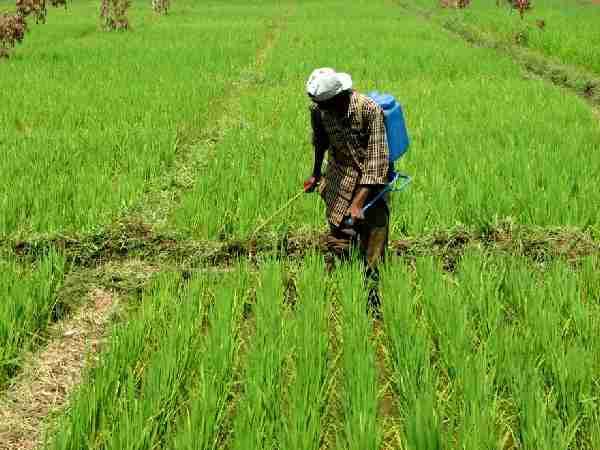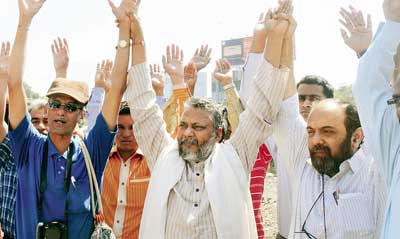News and Articles
Farmers feel left out - Budget 2011-12 is more concerned about the consumer than the farmer - Down to Earth
Posted on 23 Mar, 2011 09:43 AM43 projects sanctioned under Mission Clean Ganga - MoEF press release
Posted on 22 Mar, 2011 12:44 PM It's mandate is to ensure effective abatement of pollution and conservation of the river Ganga by adopting a holistic approach with the river basin as the unit of planning.
Allocation, release and utilization of funds for safe drinking water in rural and tribal areas under NRDWP for the last three years - PIB release
Posted on 21 Mar, 2011 12:46 PMFunds are released to the States under National Rural Drinking Water Programme (NRDWP) by the Government of India for providing drinking water supply in rural areas covering the rural and tribal areas of the State.
About 30% of rural household’s access piped drinking water from taps. However, full coverage of rural habitations is about 75%.
Pest and disease management in organic, natural, sustainable agriculture - Presentations from the South Asia Conference on "Outstanding Organic Agriculture Techniques", Bangalore organised by OFAI (2009)
Posted on 20 Mar, 2011 06:17 PM This set of presentations from the conference on Outstanding Organic Agriculture Techniques held during September 2009 at Bangalore deals with pest and disease management practices in organic farming, which rely primarily on preventive and integrated methods.
This set of presentations from the conference on Outstanding Organic Agriculture Techniques held during September 2009 at Bangalore deals with pest and disease management practices in organic farming, which rely primarily on preventive and integrated methods.
Crop production and plan protection in organic farming
This paper by S R Sundararaman presents organic farming as the only recourse for farmers, to save both livelihood and the health of the soil. Organic farming methods enable farmers save money and turn their farmyard waste into value-added products for increasing crop production. Farmers will not have to be dependent on agri-business companies for seeds, fertilizers and pesticides. Our self-reliance is thus preserved. A large portion of our country's foreign exchange is used to pay for the import of petroleum products. By going organic we will also help our country save on valuable foreign exchange. Our land will keep giving us returns for extended periods of time unlike farming as per the green revolution, where the land stays productive for a short time and then becomes sterile.
The uppermost question in the minds of farmers who have recently converted to organic farming or who want to turn organic is how to ensure that crop production does not reduce and how to protect the plants from disease, without the chemical fertilizers and pesticides that their fields have grown used to. This paper provides the answers and it also seeks to reassure all farmers that there is no farm which cannot turn around and produce quality crops in sufficient quantity, using organic farming methods.
Promoting plant health and a living soil in organic, natural, sustainable agriculture - Presentations from the South Asia Conference on "Outstanding Organic Agriculture Techniques", Bangalore organised by OFAI (2009)
Posted on 20 Mar, 2011 05:57 PM This set of presentations from the conference on Outstanding Organic Agriculture Techniques held during September 2009 at Bangalore deals with methods for promoting plant health through organic farming.
This set of presentations from the conference on Outstanding Organic Agriculture Techniques held during September 2009 at Bangalore deals with methods for promoting plant health through organic farming.
Healthy fields: Managing plant health
This presentation by S R Sundaraman of Tamil Nadu Farmers Technology Association, Erode on managing plant health begins with an account of the techniques that can be employed in TNRH 29 rice through organic SRI methods. The following are recommended in harvesting stage – (a) four irrigations with fruit gaudi (b) two applications of MEM (c) application of four sprays and (d) four applications of parasites. The growth promoters used are Archea solution, Concentrated Amudham Sol, Panchakavya, Butter Milk Sol, Fish/Egg Extract, Leaf Extract Solution-pest control and TFPE-MN Supplements. Apart from rice, the other crops dealt with are maize, kadali banana, turmeric, sugarcane and vegetables.
Plan to make major rivers pollution-free under the NRCP - PIB release
Posted on 18 Mar, 2011 02:49 PMIt covers identified polluted stretches of 39 rivers in 182 towns spread over 20 States. The major rivers covered under the Plan include Ganga, Yamuna, Gomti, Damodar, Satluj, Krishna, Musi, Cauveri and Godavari besides others. Pollution abatement schemes are taken up under the Plan on a cost sharing basis between Centre and States.
Preparedness for tsunami-like disasters - MoEF Press release
Posted on 18 Mar, 2011 01:07 PM
In the background of recent Tsunami tragedy that has struck Japan,concern has been raised in India on the safety of critical infrastructure projects located in the coastal areas, for instance, power plants, oil storage depots, refineries etc. More such projects are likely to come up in the coastal locations in the years to come.
Hazard Line Mapping
In this connection, it may be recalled that a very important component of the Rs.1200 crore project taken up by the MoEF for implementation involves identification, delineation and demarcation of the hazard line along the 5400 kms of the main coastline of India.
Bengaluru lakes to get a facelift - Down To Earth
Posted on 16 Mar, 2011 04:41 PM
Bengaluru now has an actionplan to restore its waterbodies after the Karnataka High Court accepted the report of a committee appointed to prepare a framework for the preservation of the city's lakes. The court had appointed the committee headed by Justice NK Patil in November last year to examine the ground realities while formulating a framework for restoration of lakes.
Tsunami, mangroves and market economy: No lessons learnt - Article by Devinder Sharma
Posted on 16 Mar, 2011 02:40 PMThe terrible earthquake and the disastrous sweep of the tsunami has left a trail of suffering in Japan. As our hearts go out to the Japanese, and to the impacted people, every natural disaster should provide us an opportunity to access where we have gone wrong.
